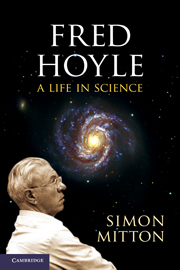Book contents
- Frontmatter
- Contents
- FOREWORD
- PROLOGUE
- 1 AN END AND A BEGINNING
- 2 TRAINING FOR COSMOLOGY
- 3 THE STAR MAKERS
- 4 HOYLE'S SECRET WAR
- 5 THE NATURE OF THE UNIVERSE
- 6 LIVES OF THE STARS
- 7 CLASH OF TITANS
- 8 ORIGIN OF THE CHEMICAL ELEMENTS
- 9 MATTERS OF GRAVITY
- 10 MOUNTAINS TO CLIMB
- 11 THE WATERSHED
- 12 STONES, BONES, BUGS AND ACCIDENTS
- ACKNOWLEDGEMENTS
- NOTES
- BIBLIOGRAPHY
- INDEX
- Plate Section
8 - ORIGIN OF THE CHEMICAL ELEMENTS
Published online by Cambridge University Press: 03 May 2011
- Frontmatter
- Contents
- FOREWORD
- PROLOGUE
- 1 AN END AND A BEGINNING
- 2 TRAINING FOR COSMOLOGY
- 3 THE STAR MAKERS
- 4 HOYLE'S SECRET WAR
- 5 THE NATURE OF THE UNIVERSE
- 6 LIVES OF THE STARS
- 7 CLASH OF TITANS
- 8 ORIGIN OF THE CHEMICAL ELEMENTS
- 9 MATTERS OF GRAVITY
- 10 MOUNTAINS TO CLIMB
- 11 THE WATERSHED
- 12 STONES, BONES, BUGS AND ACCIDENTS
- ACKNOWLEDGEMENTS
- NOTES
- BIBLIOGRAPHY
- INDEX
- Plate Section
Summary
Cosmology kept hoyle in the public spotlight for decades. In professional circles, however, he became more respected for his work on nucleosynthesis – that is, the origin of the chemical elements – an interest that preceded his cosmology. To appreciate his Olympian contributions to our present knowledge of the history of matter in the universe, we need to revisit Cambridge in the 1920s and 1930s.
Physicists at the Cavendish Laboratory had made stunning progress in probing the atomic nucleus, for which they won a string of Nobel Prizes. By the time Fred commenced research, all the components for major advances in understanding the relation of nuclear processes to the structure of stars were present in Cambridge, but no person or group seemed quite able to put all the pieces together. This was a consequence of the organization of the university in those days, which led to the dichotomy between astronomy and physics. Astronomy, a subject in the curriculum for centuries, had a higher prestige than physics, then an upstart less than fifty years old as a separate subject in the university.
In the eighteenth and nineteenth centuries, chemists isolated the elements to the point where John Dalton (1766–1844) could put together a plausible atomic theory. In St Petersburg, Dmitri Mendeleyev (1834–1907) noted similarities and patterns among the sixty-three elements then known, charting his findings in 1869 as the Periodic Table of the Elements.
- Type
- Chapter
- Information
- Fred HoyleA Life in Science, pp. 197 - 222Publisher: Cambridge University PressPrint publication year: 2011



